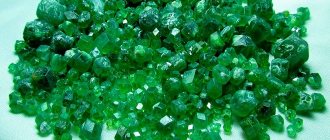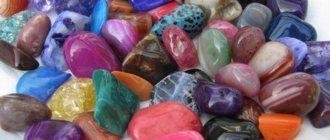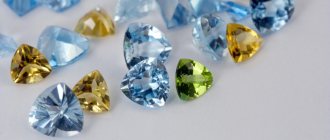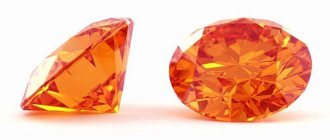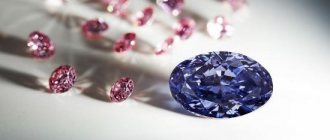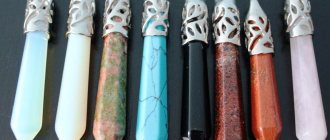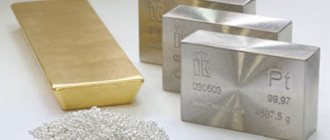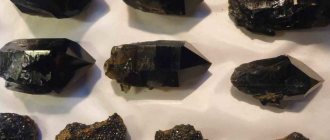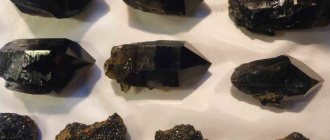Classification of stones, their origin and other features
The world of gems is harmonious and amazingly beautiful.
They can be small and large, colored and colorless, hard and fragile, transparent and not. Some are extremely rare and highly valued by jewelers. Finding others is not difficult. Being available, they are as delicious as valuable minerals. Experts have been working on the classification of stones and minerals for many years, but the division according to certain criteria is always conditional. For example, it is quite difficult to structure minerals based on an indicator such as color. Many natural stones come in a rich palette and can change shades depending on the lighting and viewing angle. Other criteria by which gems are classified include: origin, chemical and crystallographic composition, purpose, medicinal characteristics.
Gems
Precious stones include rare and expensive stones, predominantly of a crystalline nature. They can be colorless or have a beautiful uniform color. The samples are distinguished by their hardness, shine, and transparency. They are resistant to fading, thermal and mechanical stress, and have low thermal conductivity. They shimmer in the light, causing admiration.
How many valuable stones are there by gemologists? Among almost 4 thousand names of minerals, about 100 are classified as precious. In accordance with their crystal structure, they are grouped into several families. The color depends on the impurities of chromium, magnesium, iron, titanium and other chemical elements. A slight change in the chemical formula leads to the appearance of a different shade in a stone of the same grade. For example, sapphires and rubies (varieties of corundum) have identical properties. They belong to the first order precious stones. However, the ruby is wine red and the sapphire is sky blue.
The value of crystals is determined by their purity (absence of defects) and weight, determined in carats. The hardest and most expensive diamond in the ranking is the diamond from which sparkling diamonds are produced by cutting. There are colorless minerals and stones with a golden, brown tint. Multi-colored diamonds are rarely found.
Precious (aka jewelry) group.
Divided into four categories. The first includes: diamonds, emeralds, rubies and blue sapphires;
The second includes: alexandrites, jadeites, black opals, purple and green sapphires;
The third contains: white and fire opals, rhodolites, tourmalines, demantoids, topazes, aquamarines, spinel;
The fourth group included yellow, green and pink beryls, citrines, sunstone, moonstone, chrysoprase, amethysts, pyropes, kunzites, zircons, almandines, and chrysolites.
The category of jewelry and ornaments includes two subgroups. The first included rock crystal (both smoky and colorless), jades, amber (except for unique stones, which can be included in the first category along with rubies and diamonds), charoites, malachites, and lapis lazuli. The second group includes agates, feldspars, obsidians, hematites, rhodonites, and amazonites.
The next category is called - ornamental stones. This includes all other minerals, including petrified wood.
Semi-precious minerals
According to the Law of the Russian Federation “On Precious Metals and Stones,” diamond, emerald, alexandrite, blue sapphire, ruby (I order) and natural pearls are considered rare. All other names are classified as semi-precious. These are minerals that are popular in jewelry, but do not belong to the class of rare and expensive. Unlike precious ones, they are measured in grams.
Many of the gems are found in rocks in areas of extinct volcanoes and mountain ranges along with minerals. In the depths of the earth, the chemical elements that make up stones crystallize. Molecules, atoms and ions take a stable position. The structure and composition of minerals is influenced by the temperature conditions of their formation and the depth of occurrence. Pearls, corals, amber stones are of organic origin. They are formed as a result of the activity of living organisms.
The popularity of semi-precious stones is due to their wide color palette, attractive appearance and affordability. Many jewelry houses give preference to this type of stone in their collections. In the hands of experienced jewelers, raw nuggets take on shine and beauty. They become the ideal insert for modern decoration. In addition to unique external data, the samples have healing energy and magical properties.
Ornamental stones
Such gems are used to make jewelry, accessories and interior items. These are cloudy, opaque or slightly translucent stones (see photo), which are inferior in hardness to precious and semi-precious samples. Mono- or polymineral aggregates have a homogeneous structure and are highly polished. The cost of decorative stones varies from a few units to tens of dollars per kilogram. The price of cut and processed samples increases sharply.
The magical properties of aventurine
Our ancestors attached great importance to this stone.
Aventurine was believed to have special magic. In particular, the gem:
- Helps get rid of complexes and makes its owner more confident in their abilities.
- Charges with optimism and carries favorable energy.
- Helps attract and maintain love.
- Brings luck and luck in risky situations.
- Supports people seeking to change their lives.
- Helps find a way out of difficult situations.
- Promotes the development of communication skills and leadership skills.
- Improves intuition.
Aventurine is thoroughly imbued with natural energy, so it is somewhat difficult to handle. Such energy is considered unstable and capricious.
For this reason, it is not recommended to wear this stone for too long: it has the power to turn human energy 180 degrees.
The effective period for its use is considered to be the waning moon in early winter or autumn.
The magical properties of the aventurine stone are most clearly manifested in those people who are a little children at heart, or who are not burdened with constant worries.
The mineral does not help overly serious and responsible individuals. This is a stone of freedom and lightness, play and impromptu.
This is interesting! The magical properties of aventurine increase significantly when placed next to silver.
Classification of ornamental stones
According to the common classification, minerals are divided into precious, semi-precious and ornamental. The first 2 types are distinguished by their hardness and durability. They are classified as gems. According to the description, the samples are mostly opaque. They are classified according to a number of characteristics. One of the important criteria is hardness according to the Mohs table. According to this parameter, ornamental stones are distinguished:
- Hard (above 5 points). The knife will not leave marks on the surface of this group of stones. Glassy, micro- and fine-grained - microquartzites, jasper, hornfels. Different grains are called amazonite granite, quartzite, labradorite.
- Medium hardness (3-5 points). The surface can be easily scratched with a regular knife or file. Translucent - fluorite, carbonate onyx. Opaque - coil, marble.
- Soft (up to 3 points). Even fingernails and writing instruments leave marks on the stone. These are transparent alabaster, granite, selenite and opaque pyrophyllite, steatite, graphite.
Ornamental jewelry samples are set in silver or used as a decorative material. Activities to find samples are carried out by many countries around the world. There are large deposits in Russia, Madagascar, South Africa, India, Canada, and South America.
Why do you dream of brown stones?
Dreams with brown stones do not foretell mega-problems.
General interpretation
If you dreamed of brown stones (pebbles, cobblestones, bricks), this means that envious people are not asleep. They try to plot or weave intrigues behind the dreamer's back.
If a person is successful, the dream may signal: your life is the center of attention of less fortunate colleagues or neighbors. They are not averse to washing your bones at their leisure: lifestyle, wardrobe, car. But there is no need to worry about this.
The most famous jewelry and semi-precious stones and methods for determining their authenticity
The concepts of “jewelry and ornamental” and “decorative and ornamental” nuggets are usually distinguished. The first category includes samples used exclusively in the production of jewelry, the second includes minerals widely used in the construction industry and in the manufacture of figurines, souvenirs, and accessories. The rare and most beautiful of them are selected for insertion into jewelry.
The list of famous jewelry and ornamental specimens includes: chrysoprase, cat's eye (chrysoberyl), agate, heliotrope, jasper, aventurine, and the ornamental mineral tiger's eye. The stones are affordable, but this does not prevent craftsmen from releasing glass fakes to the market.
In order not to come across an imitation, when choosing, it is important to consider the following nuances:
- Natural stones are not cheap. For example, they learned to counterfeit turquoise a long time ago. Stones that are not sold in jewelry stores and are sold in large quantities are 100% fake. To create the effect of antiquity, insects are immured in golden glass imitating amber and sold at affordable prices. Authentic samples of natural resin are very rare and valuable today.
- Gems have low thermal conductivity. They are cold to the touch and remain that way for a long time, even when held in the palm of your hand. Counterfeits quickly heat up in your hand; they may be warm initially if it’s hot outside.
- When tapped, gems produce a characteristic sound that is not characteristic of glass fakes. You can compare the purchased option with another semi-precious stone. Or use a sample - pebbles. It is easy to identify a fake by the sound it makes when tapping.
- The hardness of a stone will tell you a lot about its authenticity. There are many cases where selenite (Mohs hardness 1.5-2) is passed off as a more expensive moonstone (hardness 6). There is no need to scratch or examine the stone yourself with a knife. You should ask the seller to test the product himself. For this he always has pencils and testers.
Classifying semi-precious stones is not easy. To classify them as a certain type, many criteria should be taken into account. A more reliable method of assessment is subjective. In any case, each product takes its place in the hierarchy and is valued for its unique properties.
Medicinal properties
The healing properties of aventurine apply to all human systems and organs.
With its help you can avoid the following diseases:
- Chronic skin diseases (eczema, dermatitis, subcutaneous rash, etc.). It does not get rid of the disease completely, but it helps the skin recover well. To do this, the mineral must be worn next to the lesion. For example, if allergies appear on your hands, it is enough to wear an aventurine bracelet.
- Colds , bronchitis. Jewelry with a stone must be worn around the neck.
- Thyroid diseases.
- High blood pressure. A ring framed with aventurine will help normalize blood pressure.
- Diabetes. It is enough to wear a small pendant with a gem.
- Hair loss.
- Depression and blues. It is necessary to wear a mineral set in gold on the middle finger of the hand.
In addition, aventurine helps normalize metabolism and restore the body after indigestion. The appearance of the stone has a positive effect on those who suffer from various mental disorders. In this case, massage balls will be required.
For the purpose of prevention, aventurine should be worn 4 days a week and then take a three-day break. You can wear the stone for a maximum of a month without removing it. In no case is it worth it longer. When worn for a long time, aventurine promotes excessive activation of all processes in the body, and this can cause an imbalance of energies.
Jewelry and semi-precious stones: variety and value
The value of natural jewelry and semi-precious stones is in their huge variety. Gems of the same name vary greatly in transparency, crystal size, and shade.
Absolutely transparent crystals are cut like especially precious stones. Large crystals (up to 10 carats and above), emerald or wedge-shaped cut are used to make exclusive jewelry. They are decorated in gold and platinum.
The collections of Gucci, Nina Ricci, and other world-famous brands feature expensive products with aquamarines set in precious metals.
The ornamental stone charoite is an example of a rare mineral. It was discovered in the middle of the last century and is mined in a single deposit near the Chara River, in Russia. Its intense purple color and low production volumes have made it one of the most valuable gemstones.
How are brown stones valued?
Psychologists have long appreciated the meaning of the color brown. It is associated with nature, which embodies stability, rationality, and reasonableness:
- A person who has jewelry with dark brown stones inspires respect. In the eyes of others, this is a person who knows what he wants and how to achieve it.
- Brown color “suggests” the right decisions, stimulates concentration on the important, pushes to action.
- Such accessories are chosen by people who value privacy or are tired of the bustle of the metropolis.
Light brown tones are one of the most popular in home interior design.
Types of ornamental stones
Ornamental stones are classified according to different characteristics. They are divided:
- by degree of hardness;
- values;
- mineralogical composition;
- the nature of the drawings and color inclusions;
- presence of play of light;
- degree of transparency.
According to the degree of hardness, they are distinguished:
- Soft ornamental stones – selenite, gypsum, talc-steatite. Their maximum hardness does not exceed 2.5. They are easy to process and take the desired shape, so small decorative items and jewelry are created from this type of minerals.
- Medium hard stones score 3-4 on the Mohs scale. These include malachite, serpentine, calcite, anhydrite, and fluorite. Large caskets, boxes, ashtrays, vases, and writing sets are usually made from them.
- Solid ornamental stones reach 5.5 -7 density points on the Mohs scale. Such minerals include chalcedony, obsidian, jade, agate, carnelian, jasper, pyrite, charoite, lapis lazuli, and amazonite. They are used to create pieces of furniture and interior decoration.
The value of ornamental stones depends on the effort spent on their extraction, the individual properties of the mineral: the beauty and richness of the shade, the presence of colored inclusions, the degree of opacity. Like precious gems, they are divided into classes:
- Class I stones - rose quartz, jade, lapis lazuli, agate, aventurine, amazonite, jadeite, malachite, chalcedony, charoite, jasper, labradorite.
- Class II stones - marble onyx, serpentine, anhydrite, agalmatolite, fluorite, obsidian.
- Class III stones - marble, quartzite, gypsum, breccia and other facing materials.
If a stone contains several minerals, it is classified as a rock. In rare semi-precious stones, such as moonstone and tiger's eye, one can observe the play of light and a change in color.
Agate
This beautiful ornamental stone is credited with magical properties due to its unusual design.
Color scheme : the color palette also consists of several shades, for example, white-brown, blue-blue, purple-pink.
Properties : reduces toothache, helps with insomnia.
Zodiac compatibility : Cancer and Gemini.
Jasper
There are many varieties and formulas of this mineral. It is based on quartz, chalcedony and admixtures of various less valuable minerals. Textures also vary. Black jasper is called the mineral jet.
Onyx
It looks a little like agate, so they are sometimes confused. It comes in a variety of colors: minerals are known to be black, red and green, decorated with brown stripes, and white. Onyx is used to create vases, tabletops, boxes, candlesticks, cladding and mosaics. It is mined in Asia (Pakistan, Turkey, Iran, Afghanistan), Africa (Egypt) and America (Mexico). It has healing properties and has a positive effect on the psyche.
Nephritis
Jade is a durable stone with a fibrous structure and a characteristic oily sheen. It can be transparent or opaque, most often found in gray-green, but there are varieties in white, yellow, brown and blue shades.
The price of jade depends on its color, color uniformity, and degree of transparency. This mineral is used to make jewelry, talismans, bowls, figurines, caskets, and toiletries. The most famous jade product is the 6-meter Buddha statue in China, which is made of solid stone.
Lapis lazuli
Lapis lazuli is a fairly fragile opaque ornamental stone, dark blue, bluish or greenish-gray in color. Samples of a rich blue palette are valued most highly; they are called “Lapis lazuli.”
In daylight, lapis lazuli looks bright and has a glassy luster. Under artificial light, the mineral becomes darker and duller. Lapis lazuli is actively used to create jewelry; powder compacts, amulets, boxes, vases, and artistic and decorative items are also made from it.
Calcite
Calcite is one of the most common minerals on Earth and is a form of calcium carbonate. This medium-density stone has pronounced transparency.
In its pure form, calcite is colorless; during processing it can be colored in a variety of shades. Colored samples of calcite are also found in nature; in this case, the mineral contains foreign impurities. This ornamental stone is mainly used for construction purposes and decoration. Much less often, calcite is used for decorative purposes, to create amulets, interior decorations, and souvenirs.
cubic zirconia
Cubic zirconia is an artificial mineral that is widely used in jewelry to imitate precious and semi-precious gems. It is laboratory-derived zirconium dioxide. After processing, cubic zirconia is difficult to distinguish from a diamond, so it is often passed off as the original.
The cost of the stone is small, depending on the degree of its transparency, shade and time of cultivation. Cubic zirconia is mainly used to create jewelry; they are also used to create lenses and magnifying glasses.
Fluorite
Fluorite is a calcium fluoride stone, also called fluorspar. This is a fragile mineral that has a glassy luster and sometimes contains impurities of radioactive elements - uranium, thorium. Fluorite is found in different shades: pink, blue, lilac, green, blue, yellow.
Fluorite is used to make watches, dishes, ashtrays, writing sets, vases, figurines, and powder compacts. It is often used in decorating the interior of apartments and private houses.
Turquoise
Quite difficult to process. Colors are white, blue and green. It is used to make both jewelry and stone-cutting products, usually small (writing instruments, watches).
Rose quartz
Quartz is a base mineral found in other ornamental stones. A gem from the world of emotions and feelings.
Color range : pink.
Properties : useful for diseases of the nervous and lymphatic systems.
Zodiac compatibility : Libra and Taurus.
Malachite
The bright green patterned stone is a source of pride among the gems of the Urals. Boxes and vases are often carved from it.
Color range : green in tints from light to dark.
Properties: relieves asthma attacks and has a beneficial effect on the nervous system.
Zodiac compatibility : Taurus and Libra.
Tourmaline
This mineral is used not only in jewelry, but also in medicine. The stone contains a small charge of electricity and is capable of ionizing the air around it.
Color range : green, red, blue, black, colorless.
Properties : used for air ionization and infrared heating.
Zodiac compatibility : Scorpio and Cancer.
Moon rock
This translucent mineral with a mysterious name belongs to the potassium feldspars. The shimmer and shimmer of the stone is compared to the radiance of the Moon.
Color range: white, milky, light gray, colorless.
Properties : calms hyperactive children, has a beneficial effect on brain function.
Zodiac compatibility: Scorpio, Pisces and Cancer.
Argillite
Argillite is a mineral that is classified as a rock that appeared in the process of centuries-old recrystallization and compression of clays. This stone is not valued among jewelers and is not used to create jewelry.
It is used for sculpting decorative interior elements; in molten form it is added to various building mortars.
Azurite
Azurite is a mineral that is a type of copper ore (copper carbonate). It is distinguished by a rich blue color; there are also examples of purple and blue shades.
Azurite can be opaque or translucent and has a glassy luster. Copper deposits are discovered from azurite deposits. This mineral is used to create beads, earrings, pendants, bracelets, pendants, and cufflinks. In the past, blue pigment was made from this stone for painting and icon painting.
Apatite
It is used to make jewelry and souvenirs, and is also used in industry and agriculture. There are different colors: white and red, less often blue, colorless, green and yellow. The stones used for jewelry are the smallest and perfectly clean. This mineral is quite fragile.
Ornamental stones are a vague and ambiguous concept. This includes precious minerals and minerals used in stone cutting art. Petrified wood also belongs to this category.
Artistic stone carving
This ancient art originated in China about 4 thousand years ago. Craftsmen carefully preserve the secrets of their craft and pass them on from generation to generation. Initially, jade was used as a base: regalia, body jewelry, decorative items and dishes were cut out of it. Jasper, the embodiment of virtue on Earth, was used to make religious and ritual items. Every Chinese emperor always had a personal seal made of jasper. Bottles were cut from agates and chalcedony. Turquoise, rock crystal, and amethyst attracted craftsmen with their richness of color and hardness. Eastern masters valued natural materials primarily for texture, fancy colors and shapes. Each stone was examined for a long time before work, in order to use every inclusion and vein in skillful work. “Yu carving” is still flourishing today – factories for the production of jade cups have become one of the tourist attractions of China.
Macrame with stones
The simplest weaves and knots are accessible not only to adults, but even to school-age children. Using this technique, you can braid fairly large stones, the size of a chicken egg, or weave them instead of beads into bracelets and other jewelry. In this case, you will need to drill a through hole inside each pebble.
Even ordinary braids made of thread or thin braid can be used as the main weave.
Flower pots and flowerpots
If you have a lot of pebbles, you can use them to decorate flower pots for your home and garden. This decorative technique looks best on large flowerpots and large floor pots.
The pot must first be cleaned of dirt, dried and primed. You can glue pebbles using hot glue or dilute a solution for gluing ceramic tiles (you can buy it at any hardware store). Stones can simply be glued to the surface or laid out in an ornament of stones of different shades.
Jewelry made from natural stones
Not only people can interact, make friends and quarrel. The same applies to stones and metals. Therefore, it is important to know what stones jewelry is made from, as well as what combinations of metals and crystals are found.
Natural stones in gold
Gold clashes with the following jewelry: garnet, red jasper, hematite, pink topaz. It is completely normal to combine it with stones: agate, golden topaz, onyx, emerald. But an ideal pair for gold can be a noble diamond, an unusual yellow sapphire, hyacinth, peridot, red or green amber.
Natural stones in silver
Silver does not tolerate diamonds, rubies, turquoise, zircons, beryl, and red coral. But pearls, topaz, rock crystal, malachite or lapis lazuli are much more suitable. But the best combinations with this metal are crystal moonstone, lilac amethyst, and legendary jade.
Natural stones for jewelry
As for jewelry made from natural minerals, agate, amethyst, opal, pearls, garnet, and turquoise are often used to make such products. The most popular jewelry is made from turquoise and green crystals; jewelry with amethyst is less popular.
Stone products
As a rule, rings, beads and bracelets are made from solid minerals, which do not require the participation of metals in order to secure the stone in a certain position. To make a solid product from a single crystal, it must be of significant size. Therefore, most often such jewelry is made of amethyst, citrine, quartz, morion, rock crystal, agate, jasper, and opal.
